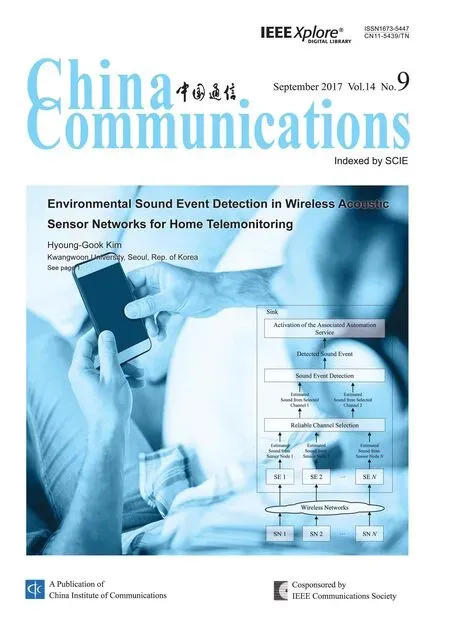Optimal Power Allocation for Multiuser OFDM-Based Cognitive Heterogeneous Networks
Yongjun Xu*, Yuan Hu, Qianbin Chen, Shun Zhang
1 Chongqing Key Lab of Mobile Communications Technology, Chongqing University of Posts and Telecommunications,Chongqing, 400065, China
2 State Key Laboratory of Integrated Services Networks, Xidian University, Xi’an 710071, China
*The corresponding author, email: xuyj@cqupt.edu.cn
I. INTRODUCTION
With the increasing number of user equipment and the development of communication technology, how to improve system capacity and efficiently achieve interference management is a key issue for future next generation communication, which has attracted more and more attention from industry and academia.Heterogeneous network (HetNet) consisting of different kinds of cellular networks can effectively improve the quality of service (QoS),energy and spectrum efficiency as well as the coverage of network due to different radio access technology (RAT) and different network structures [1]-[3]. By using the low-power base station (BS) and smaller cell radius,microcell network can enhance transmission coverage of network and eliminate the traffic blind spots of macrocell networks caused by the shadowing effect of obstacles. As a result,power allocation for HetNets with macrocell and microcell networks is very important.
Microcell network is usually distributed in the hot spots of macrocell with the 30-300 meter coverage radius so that different sizes of networks and different BSs with different transmit power coexist in same communication system. Due to the coexistence of mul-tiuser and networks, how to reduce inter-cell interference and power consumption becomes a key problem in the research of HetNets.Additionally, traditional spectrum allocation leads to underutilized spectrum, cognitive radio (CR) technology can flexibly adjust system parameters and reuse idle frequency band resource so that dynamic power allocation of cognitive-based HetNets becomes possible[4]-[5].
A distributed resource allocation algorithm is proposed to maximize the sum capacity of cognitive microcell networks in multiuser cognitive heterogeneous networks under the consideration of cross-tier interference constraint.
Power allocation (i.e., power control or resource allocation) is a key technology focused by many scholars to achieve wireless network transmission and interference management, especially for HetNets. In [6], the authors studied a sum-utility maximization dynamic resource allocation problem for the orthogonal frequency division multiplexing(OFDM)-based hybrid access cognitive femtocell networks, which is solved by using the dual decomposition method. To improve total system throughput and ease load imbalance between macro BS and picocell BS, in [7], a resource allocation algorithm via graph theory is proposed under downlink/uplink decouple access scheme for cell selection and resource allocation in a two-tier HetNet. In [8], an iteration-based resource allocation algorithm is proposed to solve the energy-efficiency(EE)maximization resource allocation problem for a single-cell HetNet with one macrocell network and one picocell network. However,multiuser and multiple cellular networks are ignored. In [9], an optimal power allocation algorihtm for a HetNet with one macro eNodeB and multiple picos is proposed to maximize total throughput of picocells under per-cell power constraint and per-tier power constraint.But only two picos are considered. In [10],the EE resource allocation problem for multimedia heterogeneous cloud radio access network is studied where the weighted-sum EE maximization problem is solved by using the generalized minimum mean-square error approach. In [11], the authors studied the transmission rate maximization power allocation problem for OFDM-based cognitive HetNets with one picocell network and one macrocell network. The resource allocation algorithm is obtained by using the Karush-Kuhn-Tucker(KKT) conditions in a centralized way. However, it only considers a single user in the HetNet, and the power constraint of mobile user is also ignored. In [12], the resource allocation problem for device-to-device (D2D)communication based heterogeneous cellular networks is studied to achieve the aggregated data rate maximization of network where D2D network and cellular network share the same licensed spectrum. In [13], a resource scheduling scheme under spectrum aggregation for CR-based HetNets is studied to support wider transmission bandwidth. In [14], a resource allocation problem for physical layer security of heterogeneous network with one hidden evaesdropper is formulated as a secrecy rate optimization problem where the eavesdropper is hidden from macro BS.
In this paper, a distributed power allocation algorithm is proposed to maximize sum data rate of cognitive-based microcell networks in a multiuser downlink OFDM based HetNet where maximum transmit power constraint of microcell BS and cross-tier interference constraint of macrocell receiver are simultaneously considered. In order to solve the formulated non-convex optimization problem, the objective function is converted into an equivalent form by introducing an auxiliary variable. Our main contributions can be summarized as follows:
● A multiuser power allocation model for downlink cognitive HetNets is built. The sum rate maximization of microcell networks is formulated under the consideration of cross-tier interference constraint, maximum transmit power of BS and the effect of intercell interference from neighboring microcell networks.
● The originally non-convex optimization problem is transformed into a geometric programming (GP) problem by introducing a relax variable, then a distributed power allocation algorithm is proposed via the Lagrange dual decomposition method.
● Simulation results demonstrate the effec-tiveness of the proposed algorithm in terms of converge performance, interference power to macrocell network and sum rate of microcell networks by comparing with the equal power allocation algorithm.
The remainder of this paper is organized as follows. System model is given in Section II. In Section III, the non-convex sum rate maximization problem is transformed into a convex form which is solved by using the dual decomposition method in a distributed way.Section IV presents the simulation results and performance analysis. Finally, Section V concludes the paper.
II. SYSTEM MODEL
A multicell cognitive HetNet consisting of one macrocell and multiple microcells is given in figure 1. The considered K microcell networks(i.e., secondary network) are randomly distributed in macrocell network (i.e., primary network), and define the setThe user set served by microcell k is defined asThe licensed frequency bands used by macrocell users is defined asThe multiple microcell BSs considered as cognitive users can dynamically detect spectrum state of macrocell network by cooperative spectrum sensing technology, then use the spectrum holes by underlay spectrum accessing way which allows both macrocell users and microcell users utilize licensed spectrum by limiting the harmful interference from microcell network to macrocell network. Assuming that both macrocell network and microcell network use OFDM transmission mechanism, as shown in figure 2.Each subcarrier is only used by one user. The total bandwidth B is divided into N subcarriers with a bandwidth ofand
Considering the interference from macrocell users and neighboring microcell users, the signal-to-interference-plus-noise ratio (SINR)over subcarrier n in the k th microcell can be formulated as

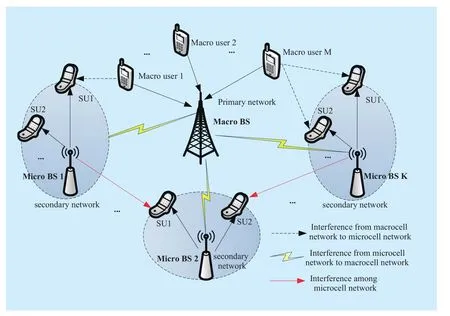
Fig. 1 System model for cognitive HetNet consisting of one macro network and multiple cognitive micro networks

Fig. 2 OFDM access model
From above equation, the first term of denominator denotes the interference power from neighboring microcell networks (i.e.,intercell interference), namely, interference among different secondary networks. The second part of denominator is the interference power from cross-layer interference of macrocell networks, namely, interference from primary network to secondary network.
Based on Shannon theorem, the corresponding data rate can be expressed as

It is obvious that data rateis proportional to its SINRfrom (2).
According to the transmission characteristic of OFDM technology, we can obtain the interference power from macrocell networks to cognitive microcell networks, namely,


To achieve resource sharing between macrocell network and microcell network, we need to consider not only sum rate maximization of microcell networks, but also limit the interference power caused from microcell networks to macrocell networks under a certain allowable range. As a result, the interference power from the n th subcarrier used by the k th microcell to the m th subcarrier is


In addition, due to the limitation of battery capacity of micro BS, the transmit power of each BS is not infinite, and we have the following constraint

To improve system capacity and spectrum efficiency, we formulate the following sum rate maximization power allocation optimization problem for multiuser cognitive HetNets,i.e.,
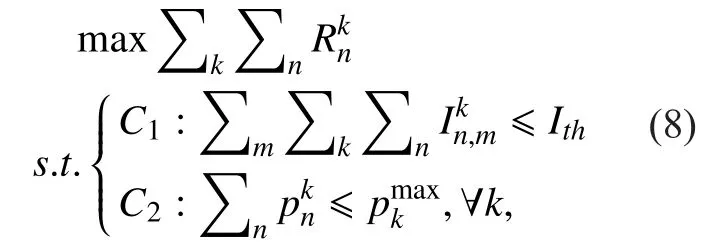
Define


It is obvious that problem (9) is a non-convex optimization, since the objective function is not a convex function with variableThe constraintsandare convex due to linear constraints. As a result, the available global optimal solution is difficult to obtain. Therefore, we require to find a feasible transformation process to solve the above problem.
III. DISTRIBUTED POWER ALLOCATION ALGORITHM
In this section, the problem (9) is firstly converted into a geometric programming problem and solved by using Lagrange dual method[15]. By using auxiliary variablewe can rewrite (9) as the following form
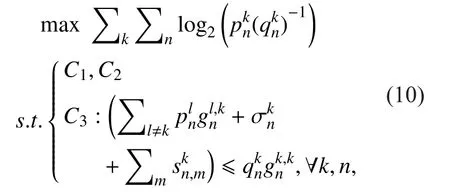

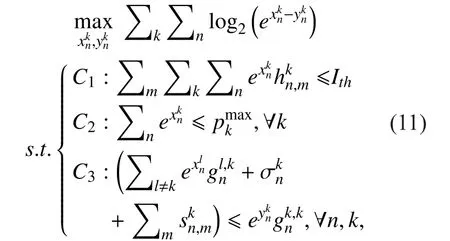
As a result, problem (11) can be reformulated as the GP problem, i.e.,
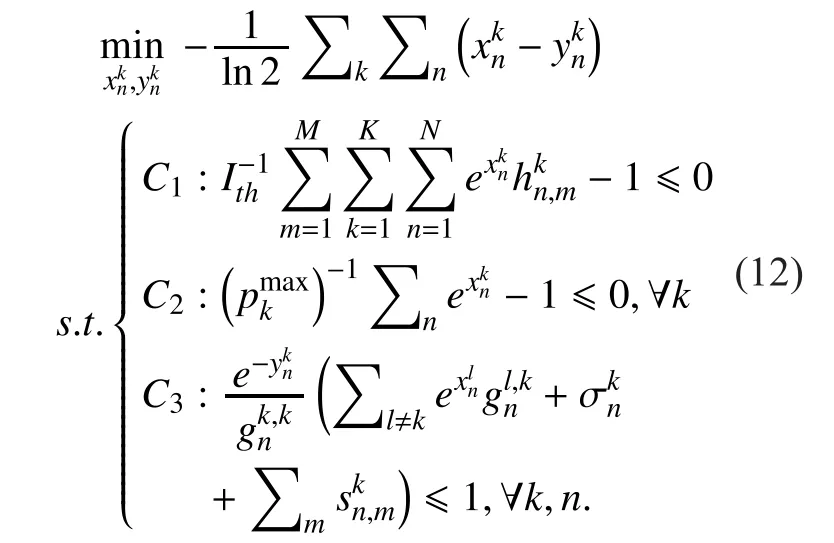
Considering the convexity of (12) [17], the Lagrangian dual function can be expressed as



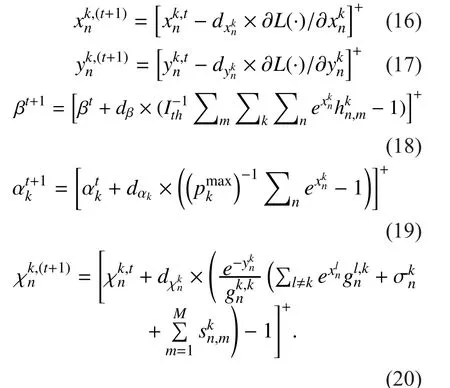
The optimal power allocation algorithm can be summarized as follows
1) Initialization:when iterationset the maximum transmit powerthe number of networks, subcarriers and usersand interference levelcell radius d is randomly chosen from the interval [0,500]m. Guarantee the primary variablesand dual variableswithin the feasible region, i.e.,andDefine the small step sizesandare randomly generated from the interval (0,0.1).
2) Update scheme at microcell user:Esti-mate interference thresholdaccording to the signals from macrocell transmitters. Measure background noiseand estimate channel gain of microcell usersCalculate the dual variableby using (20). Feedbackandto the microcell BS.
3) Update scheme at microcell BS:Receiveand, estimate channel gainUpdate dual variablesandby (18) and (19), calculateandby(16) and (17). Obtain the transmit power by using
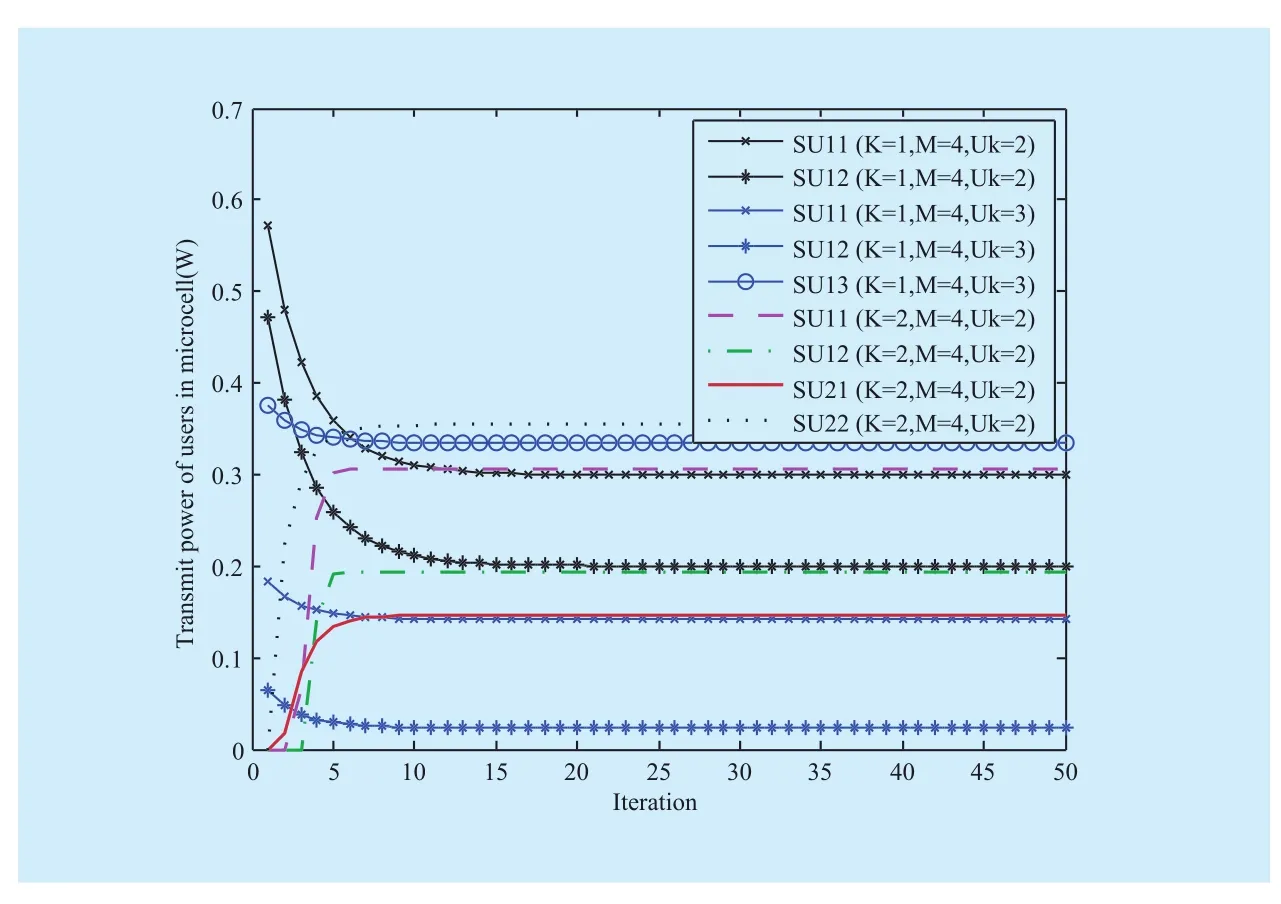
Fig. 3 Transmit power of users versus number of iterations with different network scenarios
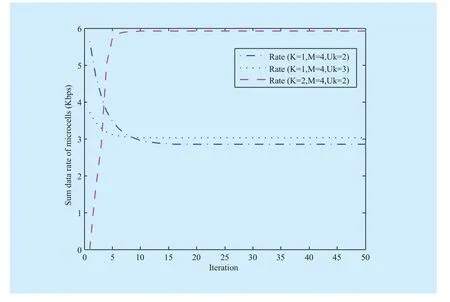
Fig. 4 Total transmission rate of microcell networks versus number of iterations with different scenarios
4) Go to step 2).
IV. SIMULATION RESULTS
In this section, the system performance for the proposed power allocation algorithm (PAA) is evaluated with several simulations. Assuming that cognitive microcell networks are randomly distributed in the macrocell network. The cell radii of microcell and macrocell network are 30m and 500m, respectively. The total bandwidth isMHz, and the bandwidth of each subcarrier isKHz. The path loss between macrocell base station and its served users is 128.1+37.6log(d) (dB), where d denotes the distance between base station and user equipment. The path loss between macrocell networks and microcell networks is 140.7+36.7log(d)(dB). The path loss between microcell base station and its users is 122+38log(d)(dB). The background noise is 110dBm, the maximum transmit power of each microcell base station is assumed to be 0.5W. The cross-tier interference threshold is
Figure 3 illustrates the transmit power convergence of cognitive microcell networks under different user scenarios. We assume that there is one macrocell network with four users,i.e.,. We consider three cases, namely,case 1: one microcell network with two cognitive users, case 2: one microcell network with three cognitive usersand case 3: two microcell network with two users
It can be directly observed that the transmit power of microcell user quickly converges to the equilibrium point (i.e., the optimal value).In addition, the transmit power of both SU11and SU12in case 2 is smaller than that of case 1, since new user will share the system resource with the two existing users by accessing into the network, however, the transmit power of old usersdecreases by the limitation of maximum trans-mit power of the k th cognitive base station(e.g., microcell base station). On the other hand, the transmit power of SU11and SU12is also affected by the neighboring microcell network (i.e., case 3). When there are more microcell networks in the macrocell networks,more interference from same networks can influence the transmit performance of existing users so that the transmit power of SU12under case 3 is lower than that of case 1.
Figure 4 shows the total data rate of microcell networks under different cases. It is clear that the case 3 has the highest data rate due to two cognitive cellular networks. Combining figure 3 and figure 4, although the transmit power of SU11and SU12under case 2 is lower than that of case 1, the sum data rate of network under case 2 is higher than that of case 1 since more users can improve the overall system performance. Meanwhile, the sum data rate of SU11and SU12under case 3 (i.e.,the lowest one) is lower than that of case 1,because more harmful interference from new cognitive cellular network decreases system performance of existing network.
In order to evaluate the effect of transmission power of microcell networks, figure 5 presents the interference caused by the microcell networks to the macrocell network.From the figure, we know that the interference power to the macrocell network increases with the increasing cognitive cellular users (i.e.,and the number of microcell network (i.e.,K ). Although the total capacity of microcell network under case 2 is better than that of case 1, they cause more harmful interference to the macrocell users under the limitation of cross-tier interference.
In order to evaluate the performance of the proposed power allocation algorithm (Proposed PAA), we compare the proposed PAA with the equal PAA (i.e., equal transmit power allocation algorithm). The simulation results are shown from figure 6 to figure 7.
Figure 6 shows the sum data rate of microcell networks versus maximum transmit power of microcell BS under different schemes. It is obvious that the sum data rate under the proposed PAA is higher than that of the equal PAA under different network scenarios. In addition, the data rate increases with the increasing maximum transmit power under certain interference power threshold of macrocell network (i.e., Ith=0.006W), since the bigger allowable maximum transmit power makes the feasible region be bigger so that microcell BS can further improve system performance by allocating more power to the related links.Additionally, the data rate under equal PAA is very close to that of proposed PAA under case 1 since there are not many users (users=2) in the network and the difference between the optimal power and the allocated equal power is small. As a result, the difference between the proposed algorithm and the equal PAA is not very obvious under this case. With the increasing of microcell users and the number of microcell network, there is huge difference in the data rate.

Fig. 5 Interference power to the macrocell network versus number of iterations with different scenarios
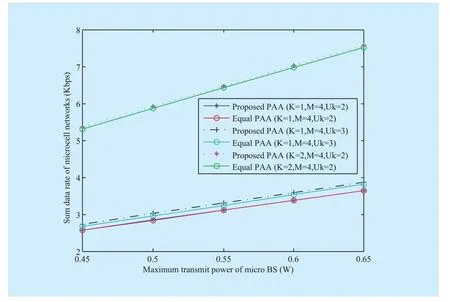
Fig. 6 Maximum transmit power vs sum rate of microcell network
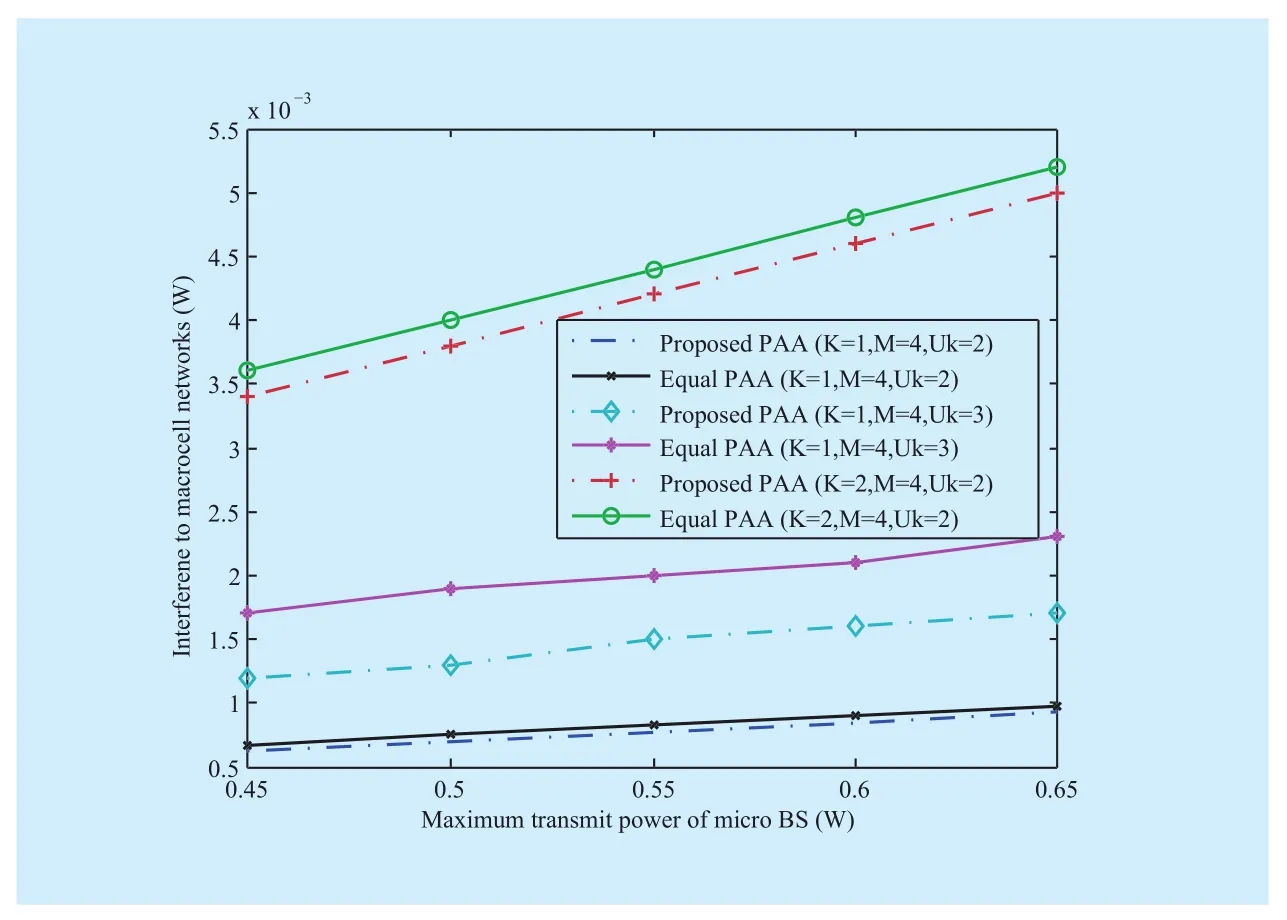
Fig. 7 Maximum transmit power vs interference power to macorcell user

Fig. 8 Actual transmit power at microcell BS vs the interference power threshold
To further show the effectiveness of the proposed scheme, we compare with the existing power allocation scheme in [11], as shown in figure 8. In order to discuss the problem conveniently, we assume that there is one microcell with two users and one macrocell with one user. The maximum transmit power is assumed to be
From the figure, the actual sum transmit power at BS improves with the increasing interference threshold. Under the low region of interference power, the effective transmit power of BS is limited by the interference threshold which is used to protect the basic performance of macrocell user. However, for the power allocation algorithm in [11], the actual sum transmit power exceeds the allowable value of BS under high interference threshold since it ignores the limitation of capacity at BS. The sum transmit power of proposed scheme keeps the stable status due to the limitation of maximum transmit power ahead of time. Additionally, its corresponding sum data rate is superior to that of algorithm in [11].Because the bigger transmit power is allowed.
V. CONCLUSION
In this paper, to well ensure the QoS of macrocell cellular networks and improve system capacity, a distributed resource allocation algorithm is proposed to maximize the sum capacity of cognitive microcell networks in multiuser cognitive HetNets under the con-sideration of cross-tier interference constraint.Through using exponential transformation, the original non-convex optimization problem is transformed into an equivalent optimization problem solved efficiently by the Lagrangian dual method. The simulation results show that the proposed algorithm can fast converge to the optimal value with a small number of iterations. It is also obvious that our scheme can well protect the transmission performance of macrocell users and have a better performance by comparing with equal power allocation algorithm. The efficient resource allocation with consideration of parametric uncertainties (e.g.,channel uncertainties) in cognitive HetNets will be investigated in our future work.
ACKNOWLEDGEMENTS
This work was supported by the National Natural Science Foundation of China (Grant No. 61601071), the Scientific and Technological Research Program of Chongqing Municipal Education Commission (Grant No.KJ16004012), the Municipal Natural Science Foundation of Chongqing (Grant No.CSTC2016JCYJA2197), the Seventeenth Open Foundation of State Key Lab of Integrated Services Networks of Xidian University(Grant No. ISN17-01), the Dr. Startup Founds of Chongqing University of Posts and Telecommunications (Grant No. A2016-12).
[1] H. Elsawy, E. Hossain, D. I. Kim, ‘’HetNets with cognitive small cells: user offloading and distributed channel access techniques’, IEEE Communication Magazine, vol. 51, no. 6, pp. 28-36,June, 2013.
[2] C.-W. Chang, ‘’An interference-avoidance code assignment strategy for the hierarchical two-dimensional-spread MC-DS-CDMA system: a pro-totype of cognitive radio femtocell system’,IEEE Transactions on Vehicular Technology, vol.61, no. 1, pp 166-184, January, 2016.
[3] M. Adedoyin, O. Falowo, ‘’Self-organizing radio resource management for next generation heterogeneous wireless networks’, Proceedings of the IEEE Interference Conference on Communications (ICC2016): Kuala Lumpur, pp. 1-6, 2016.
[4] P. Leaves, K. Moessner, R. Tafazolli, et al, ‘’Dynamic spectrum allocation in composite reconfigurable wireless networks’, IEEE Communications Magazine, vol. 42, no. 5, pp. 72-81, May 2004.
[5] Y.J. Xu, X.H. Zhao, Y.C. Liang, ‘’Robust power control and beam-forming in cognitive radio networks: a survey,’ IEEE Communications Surveys & Tutorials, vol. 17, no. 4, pp. 1834-1857,Fourthquarter 2015.
[6] L. Zhang, T. Jiang, K. Luo, ‘’Dynamic spectrum allocation for the downlink of OFDMA-based hybrid-access cognitive femtocell networks’,IEEE Transactions on Vehicular Technology, vol.65, no. 3, pp. 1772-1781, March, 2016.
[7] L.W. Jiang, X.J. Sha, X.L. Wu, N.T. Zhang, ‘’A novel resource allocation algorithm based on downlink and uplink decouple access scheme in heterogeneous networks’, China Communications, vol. 13, no. 6, pp 22-31, June, 2016.
[8] J.M. Jiang, M.G. Peng, K.C. Zhang, et al, ‘’Energy-efficient resource allocation in heterogeneous network with cross-tier interference constraint’, Proceedings of the IEEE 24th International Symposium on Personal, Indoor and Mobile Radio Communications (PIMRC Workshops), London, pp. 168-172, 2013.
[9] W.N. Zhou, Y.J. Xu, T. Liang, X.T. Ren, ‘’Optimal power allocation for heterogeneous network capacity maximization’, China Communications,vol. 10, no. 9, pp. 97- 103, September, 2013.
[10] M.G. Peng, Y.L. Yu, H.Y. Xiang, H.V. Poor, ‘’Energy-efficient resource allocation optimization for multimedia heterogeneous cloud radio access networks’, IEEE Transactions on Multimedia, vol.18, no. 5, pp. 879-892, May, 2016.
[11] Z.S. Fei, C.W. Xing, N. Li, et al, ‘’Power control for OFDM-based cognitive heterogeneous networks’, Science China Information Sciences, vol.56, no. 10, pp. 1-10, April 2013.
[12] X.Q. Ma, J.C. Liu, H.B. Jiang, ‘’Resource allocation for heterogeneous applications with device-to-device communication underlaying cellular networks’, IEEE Journal on Selected Areas in Communications, vol. 34, no. 1, pp 15-26,January, 2016.
[13] Y.H. Fu, L. Ma, Y.B. Xu, ‘’A resource scheduling scheme for spectrum aggregation in cognitive radio based heterogeneous networks’, China Communications, vol. 12, no. 9, pp. 100-111,September, 2015.
[14] S.Q. Gong, C.W. Xing, Z.S. FEI, et al, ‘’Resource allocation for physical layer security in heterogeneous network with hidden eavesdropper’,China Communications, vol. 13, no. 3, pp. 82-95, March, 2016.
[15] N. Gatsis, A.G. Marques, G.B. Giannakis, ‘’Utility-based power control for peer-to-peer cognitive radio networks with heterogeneous QoS constraints’, Proceedings of the IEEE International Conference on Acoustics, Speech and Signal Processing (ICASSP 2008), Las Vegas, pp. 2805-2808, 2008.
[16] M. Chiang, ‘’Geometric programming for communication systems’, IEEE Transactions on Wireless Communications, vol. 6, no. 7, pp 2640-2651, May 2007.
[17] S. Boyd, L. Vandenbergh, Convex Optimization,Cambridge University Press, 2004.
[18] YJ. Xu, X.H. Zhao, ‘’Robust power control for underlay cognitive radio networks under probabilistic quality of service and interference constraints’, IET Communications, vol. 8, no. 18, pp.3333-3340, December, 2014.
- China Communications的其它文章
- An Iterative Detection/Decoding Algorithm of Correlated Sources for the LDPC-Based Relay Systems
- Homomorphic Error-Control Codes for Linear Network Coding in Packet Networks
- Polar-Coded Modulation Based on the Amplitude Phase Shift Keying Constellations
- A Privacy-Based SLA Violation Detection Model for the Security of Cloud Computing
- An Aware-Scheduling Security Architecture with Priority-Equal Multi-Controller for SDN
- A Flow-Based Authentication Handover Mechanism for Multi-Domain SDN Mobility Environment

